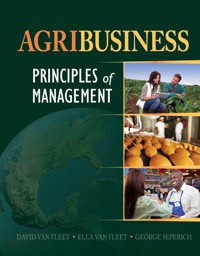We humans are hard wired. Our psyches say we must work, but we are also social animals.
Question:
We humans are “hard wired.” Our psyches say we must work, but we are also social animals. We work to live; we work to socialize. And both are accomplished in organizations.
Next to agriculture, the second oldest legal occupation on planet Earth is fishing. When man encountered bodies of water, he/she learned that water could be a source of food. Getting the food, however, was not an easy task; the prey was elusive and required a very different skill set than land-based hunting. So it was that since the dawn of civilization two different industries developed simultaneously. Agriculture required one set of skills—to grow and nurture food production, not just hunt for it. Fishing required a transfer of the hunter-gatherer instincts developed on land to a new environment—water. Each industry provided sustenance, commerce, and work. Each industry provided a livelihood. One represented “new technology”—farming; the other, an extension of the hunter-gatherer lifestyle to a new environment—
water. Both required organizations.
This division between livelihoods has existed for thousands of years. Farmers have farmed and fishermen have fi shed, while other humans have reaped the benefit of their labors through a diversified and broad nutritional base, commerce and trade. At the beginning of the twenty-first century, however, this ancient dichotomy seems about to be broken. The irony of the rupture is that it emanates from the success of organizations in both industries.
The Food and Agriculture Organization (FAO) of the United Nations characterizes the fisheries industry as about to enter its “last stand.” Among 600 marine fish species, only 4 percent are underexploited or recovering from depletion, i.e. are of viable commercial use. This means that 96 percent of marine fish species are characterized by a gradient from moderate exploitation to depleted stocks. Indeed, in 2006 newspaper headlines shouted, “All Seafood Will Run Out by 2050, say Scientists.” Global fishermen have been doing their job too well. Attempts to establish moratoria on various species often have not succeeded since it takes only one country to ignore the stoppage before others cave in. Something must be done. Fish is far too important as a protein source for our species and as a means of preserving genetic diversity in the water.
Into this fray, agriculture entered, applying the techniques of land-based crop production to fish production.
After a slow start the “aquaculture” industry has come into its own. As of 2010, aquaculture in the United States was a $1.5-billion dollar industry distributed over 4,800 farms. The largest segment of the industry, 43 percent, involved the production of food fi sh. This segment was followed by mollusk (oysters and clams) farms, crustacean farms, bait fish farms, and sport fish farms, respectively. Even with this assistance from aquaculture to the fishing industry, the United States remains a net seafood importer. The two industries coexist peacefully.
Unfortunately, organizations in the agricultural industry have not stopped tinkering with this “thorny” problem and the fishing industry is now getting upset. A U.S. company, AquaBounty Technologies, Inc., has developed an Atlantic salmon that grows twice as fast as conventionally farmed fish and its wild cousin. The Food and Drug Administration has tested the “new” fish and found that chemically and biologically it is identical to its conventional Atlantic salmon cousin. Many folks are upset, including Gloucester Fisherman’s Wives Association of Massachusetts, Senator Lisa Murkowski (R-AK), Pacific Coast Trollers, Atlantic fishing companies and Stonyfield Farm (yogurt manufacturer). Is it smart to play with Mother Nature?
Two issues are involved: the intrusion of agriculture into the hunter-gatherer lifestyle of fishing (a removal of the separation between the two) and the imposition of a genetically modified organism as a solution for the fishery industry. The “new” salmon has added a gene from another type of salmon, the Chinook, that encourages a faster growth rate; and the gene is “turned on” by a gene from the eel-like ocean pout, another salmon. Land agriculture is already employing this technology so it can feed the expected nine billion people on this planet. The extension of gene technology seems very obvious to organizations in agriculture, but not to those in fisheries.
QUESTIONS
1. What form of organization might be best in each of these industries? Why?
2. Would the forms of organization likely be different or similar in these two industries over time?
3. In organizations within these two industries, how would the corporate cultures differ and how would they be similar?
Step by Step Answer:

Agribusiness Principles Of Management
ISBN: 9781285952352,9781285947839
1st Edition
Authors: David Van Fleet, Ella Van Fleet, George J. Seperich





